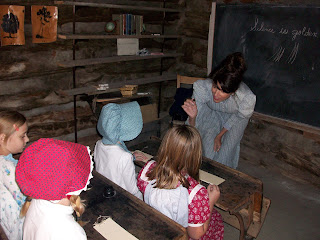Morgan was so excited to go to the pioneer school and be a "pioneer girl" for the day. She was so excited, she didn't sleep much last night. "I think it will be so cool to live like a pioneer. But not all the time. Just for one day maybe."
Morgan was also excited that I was coming with her. We packed our lunch of jerky, muffins, and apples in our basket and loaded into the wagon (bus) early this morning. It was a long ride out to the Flowerfield school in Banner County.
The teacher, Miss Herdel, started the day by ringing the bell. Time to
line up, boys on one side and girls on the other, for boys and girls are
not allowed to co-mingle, and it is always ladies first.
They started their school day as if they were in the year 1888. They said the Pledge of Allegiance as it would have been said then and sang "My Country 'Tis of Thee" with the pump organ.This was the "new" school house / church / community center that had been built to replace the original school.
The kids read from their readers at the recitation bench. They practiced their orthology (spelling) and their arithmetic on slates.
And they took turns going to the original school house to practice their penmanship.
The original building was about 10x10 inside and at one time there were 21 students who met here. One cold, snowy, windy, winter day they even brought a horse inside for the school day.
Ms. Thompson showed them how to dip just the end of their quill into the inkwell.
Writing with a feather is harder than it looks.
Morgan volunteered to help show how the dunce cap was worn. They had a lot of rules to follow back then and the punishments were pretty severe. Miss Herdel carried the rod and used it to point to things but she also explained how it was used to give lashings. Ouch!
Before they could eat lunch, the children had to wash their hands with lye soap. The doctor had just come through town and explained how important it is to wash hands and keep clean. Everyone must bathe once a week. Doctors orders. Once per winter is simply not enough.
The kids paused for a group picture.
Then we went to the picnic shelter for lunch. (We did have some modern conveniences like real toilets too.) We tried to stay in the sunshine because there was an icy breeze blowing.
Then we got to see what life would have been like in a log cabin. Because trees in this part of the state were hard to come by, not many homesteaders had log homes.
The kids learned about chamber pots and bustles, and wash tubs for bathing in. Most decided it would have been best to be the youngest in the family back then. Sharing the same bath water did not sound so fun.
Covered wagons were called prairie schooners because they looked like little boats floating through the sea of tall grass. On the other side of the state, the grass was 8 feet tall or higher.
The sod house was even smaller than the school house. And very cold inside! (Sod is good insulation.) With a dirt floor, the bathe water was poured right onto the floor inside. This helped settle the dust until enough manure was collected to make a nice finish on the floor.
The bird cage in the background would normally have been hung on a hook outside the front door. The settlers came from the East, where there were trees and birds. They would catch a bird and keep it in a cage by the front door so they wouldn't be so homesick.
We also visited the General Store which was made from rock. Most of the buildings in this area were made from sod or rock. A lot of settlers lived in dugouts in the side of a hill until they were able to get their homes built. If the family could live on the land, and improve it, for 5 years then they got to keep their 640 acres free of charge.
What a great way for the kids to learn about the life of a pioneer!


















No comments:
Post a Comment